Neurons and Glial Cells
Jim Hutchins
Objective 1: Compare and contrast neurons and glial cells.
Neurons
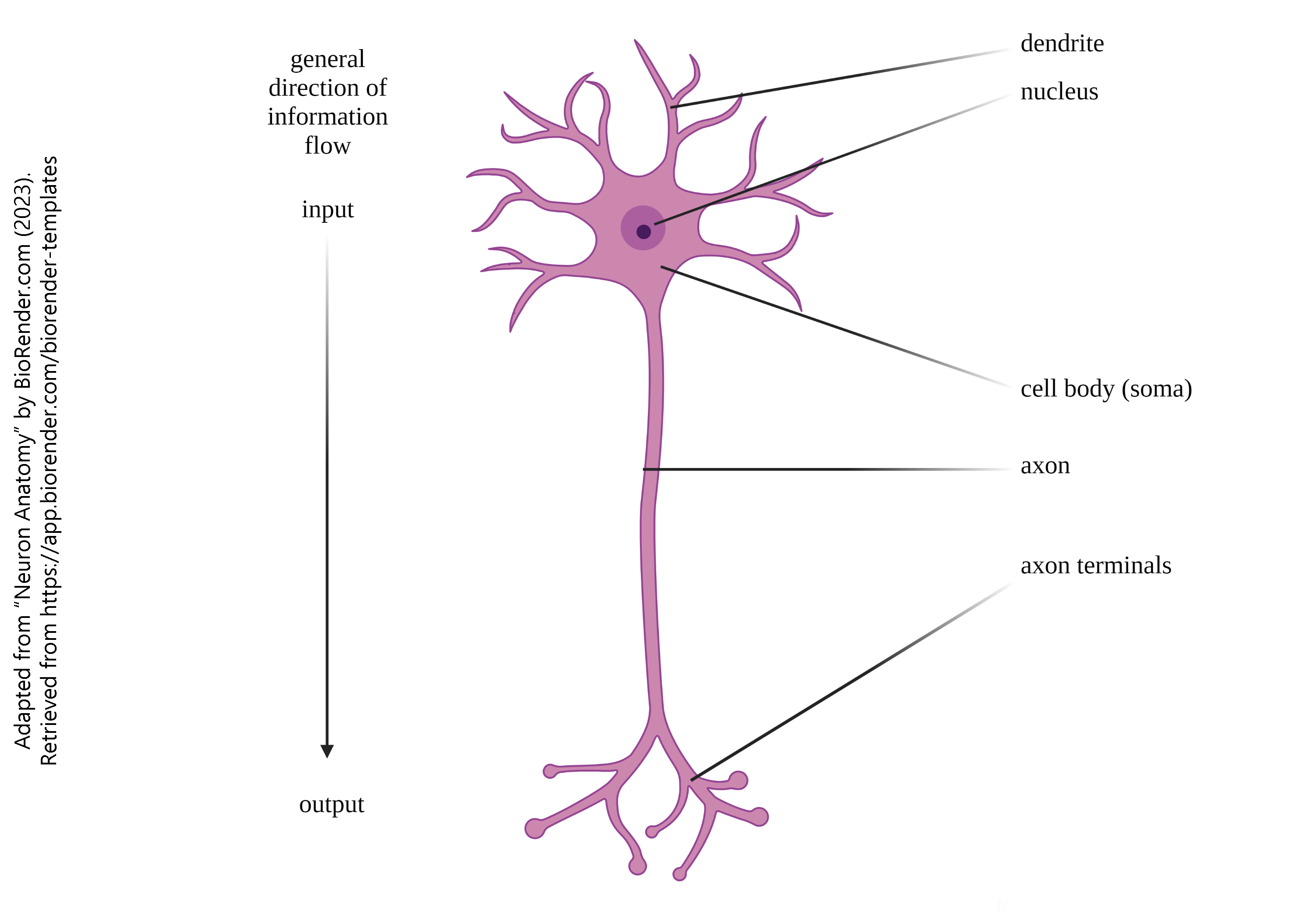
Most artists who draw a “typical” neuron draw a shape we call multipolar. We will look at neurons at a molecular level of detail in subsequent chapters. For now, we’ll name some microscopic parts of the neuron that are important for its function:
- dendrites, tree-like extensions of the cell body;
- cell body, or soma, the area where the nucleus and most organelles reside;
- axon, the “cable” of the neuron
It’s important to remember that very few actual neurons operate exactly the way we’re describing here. Rather, we’re taking the properties of 80 billion neurons with thousands of different shapes and making some general “rules” about what the different parts do. Along the way, we’ll find plenty of exceptions to these general rules.
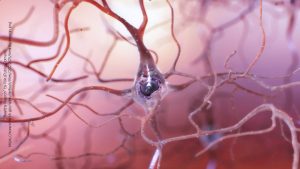 A multipolar neuron has an extensively branched tree surrounding its cell body. Fittingly, these branches are called dendrites (Greek δενδρον, dendron, “tree”). The dendrites are, in general, where a neuron receives information. Even neurons without an obvious tree receive information in a modified, unrecognizable dendrite (such as the lamellated corpuscle we saw in the skin).
A multipolar neuron has an extensively branched tree surrounding its cell body. Fittingly, these branches are called dendrites (Greek δενδρον, dendron, “tree”). The dendrites are, in general, where a neuron receives information. Even neurons without an obvious tree receive information in a modified, unrecognizable dendrite (such as the lamellated corpuscle we saw in the skin).
The dendrites are also used in the initial stages of information processing. The dendrites and soma together determine what information is going to be transmitted to another cell or to a target organ. We’ll discuss the details of this process in the chapter on information processing within neurons.
Information coming into a fine, faraway dendritic branch has less of an effect on the output of a neuron than information coming into a thicker, nearer branch.
The metabolic center of a neuron, which includes the cell nucleus, is the cell body or soma. The cell body aids in the processing of information.
After information is gathered at the dendrites, and processed via the dendrites and cell body, a decision has to be made: do we give that information to another cell? This decision is made at a point that naturally enough has the nickname of the decision point.
The output of a neuron travels through its axon. If the information must travel a long distance, the axon is myelinated: it is covered by an insulated sheath. In some neurons, the myelin sheath is interrupted periodically at points called the nodes of Ranvier.
The axon ends in one or more axon terminals (or terminal knobs or terminal boutons). These are the sites where information is sent to the next neuron in line, or to muscles or glands, a specialized structure called the synapse.
We will study the molecular machinery of the synapse in another chapter. For now, all we need to know is that an individual neuron makes a lot of synapses; 10,000 synapses would be a rough average number for a typical neuron. Each of these synapses transfers information to a target cell using chemical signals called neurotransmitters.
The side of the synapse which sends information is the presynaptic side. The axon terminals of an α motor neuron would be an example. The side which receives information is the postsynaptic side. The muscle cell of the neuromuscular junction would be an example. The postsynaptic side contains neurotransmitter receptors which can either change the electrical properties of the postsynaptic cell, or the biochemical properties, or both.
Glia
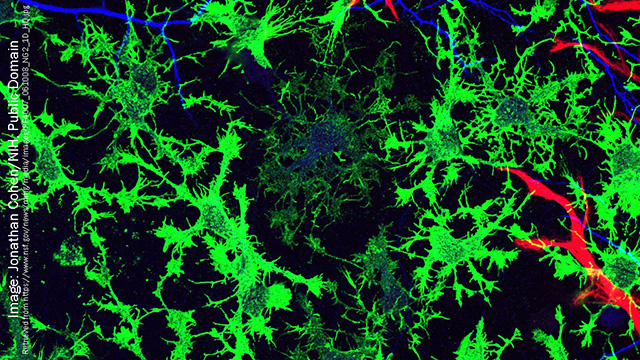
There are two main cell types in the brain. Neurons are what we generally think of when we think of “nerve cells”. Remember that these are the cells that receive, process and transmit information in a point-to-point fashion in the nervous system. There are about 80 billion neurons in the human nervous system, but no one can possibly count them, so that’s just an estimate.
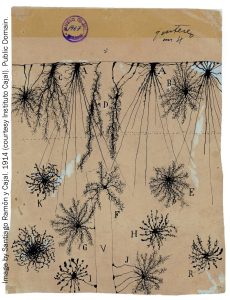 Another roughly 80 billion cells in the brain are glial cells or glia (Greek λοια, gloia, “glue”). For a long time, no one wanted to study cells whose name made people think of “Elmer’s” or the kid in first grade who ate paste. Recently, however, glial cells have come into their own as a field of study. Glial cells maintain the structural and chemical environment of the brain, and function in ways we probably don’t fully appreciate. For example, Einstein’s brain had the same number of neurons as you and I, but more glial cells than normal1. The image here, from Ramón y Cajal’s drawings, shows the glial cells in the cerebral cortex of a human child.
Another roughly 80 billion cells in the brain are glial cells or glia (Greek λοια, gloia, “glue”). For a long time, no one wanted to study cells whose name made people think of “Elmer’s” or the kid in first grade who ate paste. Recently, however, glial cells have come into their own as a field of study. Glial cells maintain the structural and chemical environment of the brain, and function in ways we probably don’t fully appreciate. For example, Einstein’s brain had the same number of neurons as you and I, but more glial cells than normal1. The image here, from Ramón y Cajal’s drawings, shows the glial cells in the cerebral cortex of a human child.
There are four types of glial cells:
- astrocytes (astroglia),
- oligodendrocytes (oligodendroglia),
- microglia, and
- ependymal cells
Astrocytes (Astroglia)
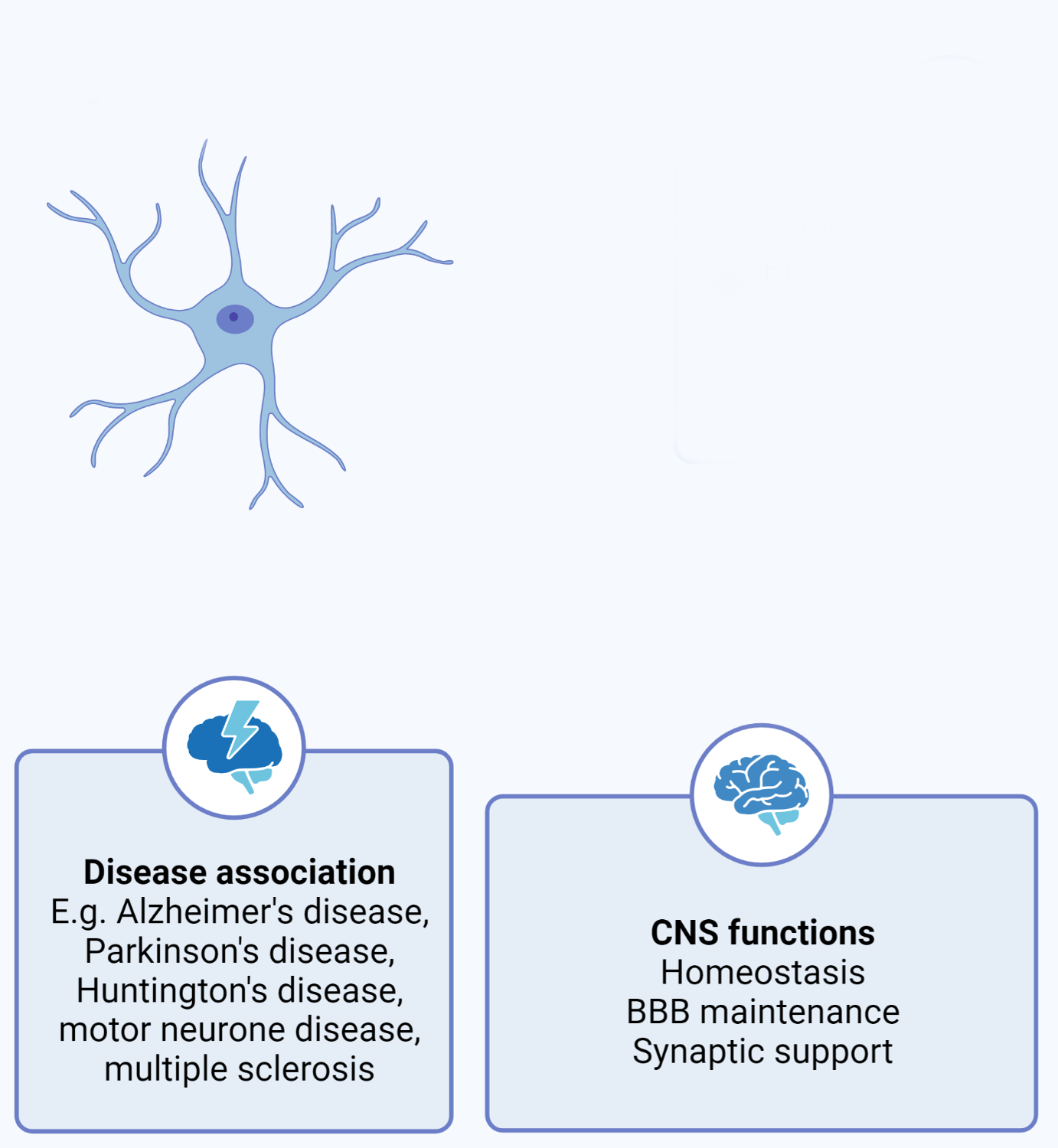
Astrocytes (also called astroglia) form the borders of the CNS.
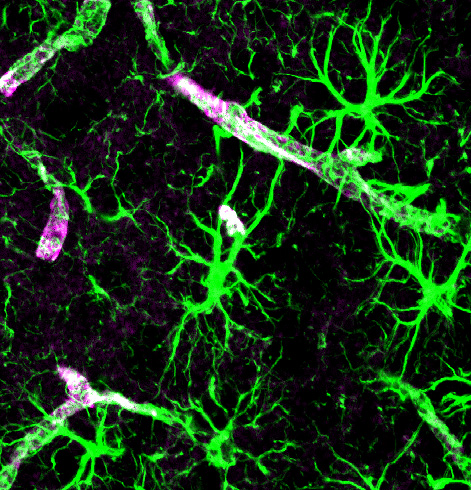
They cooperate with blood vessels to form the blood-brain barrier (BBB), which permits only lipid-soluble substances, certain amino acids, and glucose to pass (we introduced the BBB earlier). This helps protect the brain from chemical or microbiological damage, but also makes it hard for the body to mount a defense against something that circumvents the BBB.
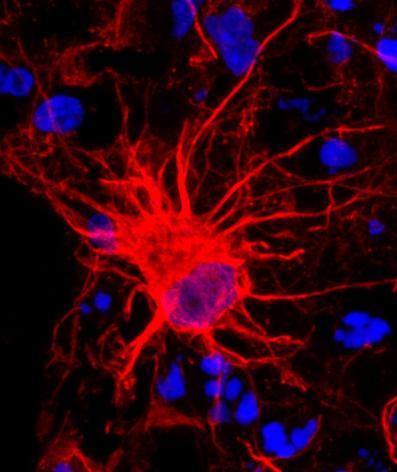 The end-feet of astrocytes make up the pia mater, one of the coverings on the outside of the brain. Astrocytes also wall off groups of neurons and act as sponges to soak up potentially harmful ions and waste products.
The end-feet of astrocytes make up the pia mater, one of the coverings on the outside of the brain. Astrocytes also wall off groups of neurons and act as sponges to soak up potentially harmful ions and waste products.
Oligodendrocytes (Oligodendroglia)
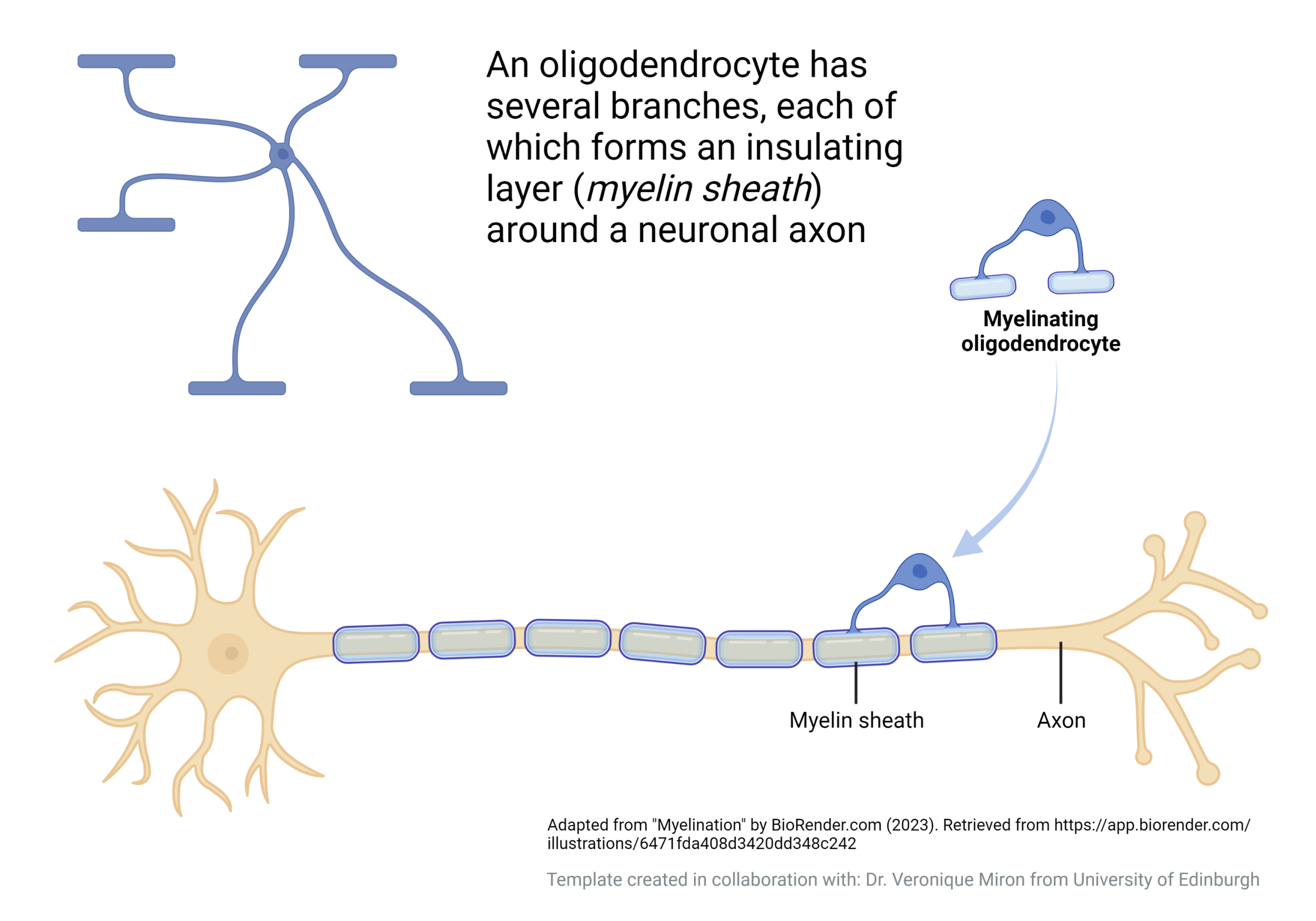 Oligodendrocytes (also called oligodendroglia) have only one job, but they do it well. They form myelin sheaths which insulate nerve axons that must send information over long distances. In order to ensure propagation of the action potential, the myelin sheath must have gaps every few hundred micrometers. These gaps are called the nodes of Ranvier.
Oligodendrocytes (also called oligodendroglia) have only one job, but they do it well. They form myelin sheaths which insulate nerve axons that must send information over long distances. In order to ensure propagation of the action potential, the myelin sheath must have gaps every few hundred micrometers. These gaps are called the nodes of Ranvier.
Microglia
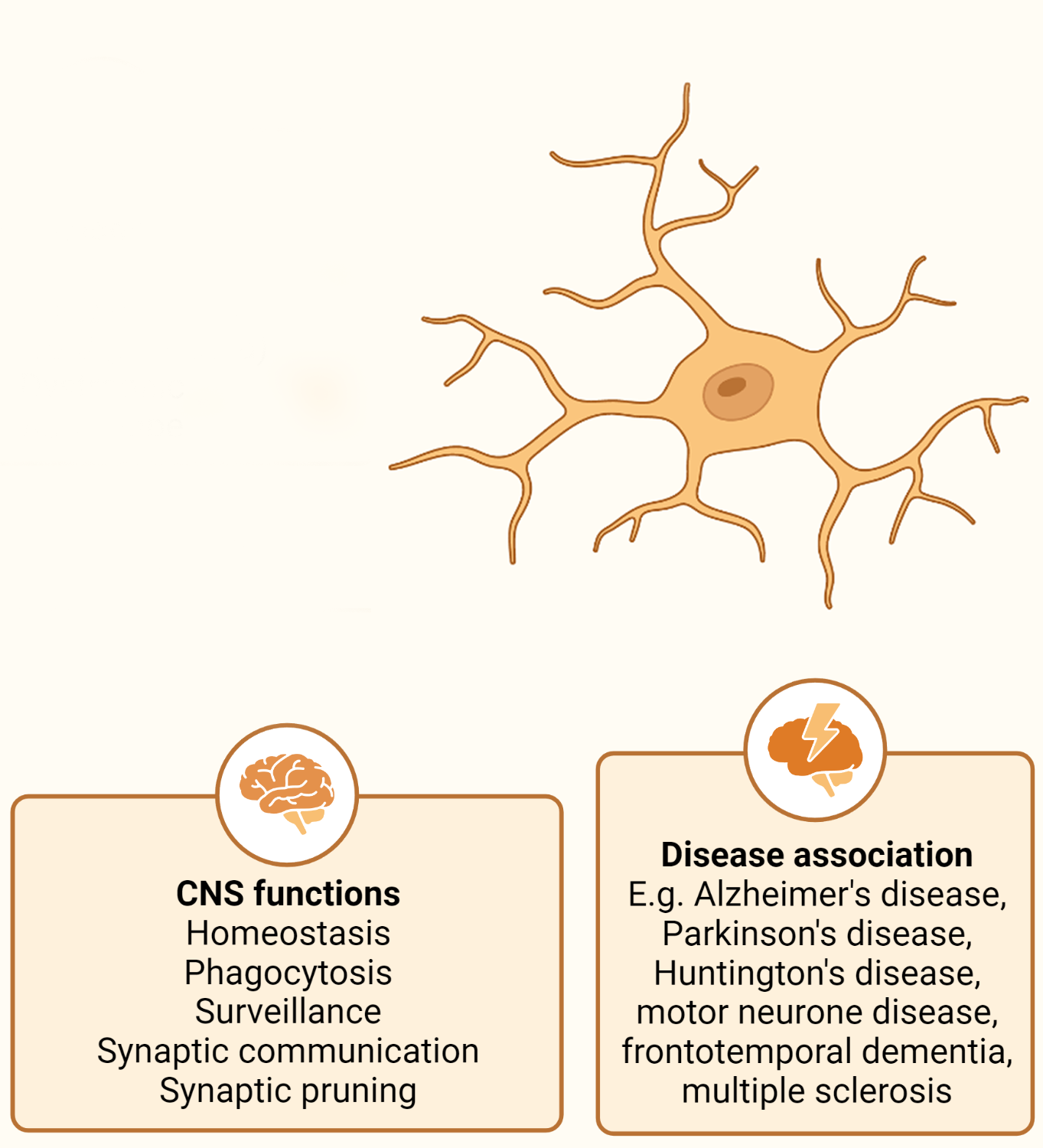
Immune cells called macrophages reside in tissues other than the brain. Macrophages swallow and digest invaders and waste products.
Microglia are the brain’s equivalent of macrophages. The brain is termed an “immunologically privileged site”, so no immune cells can pass the BBB. Only microglia are normally allowed to carry out immune functions in the brain.
Ependymal Cells
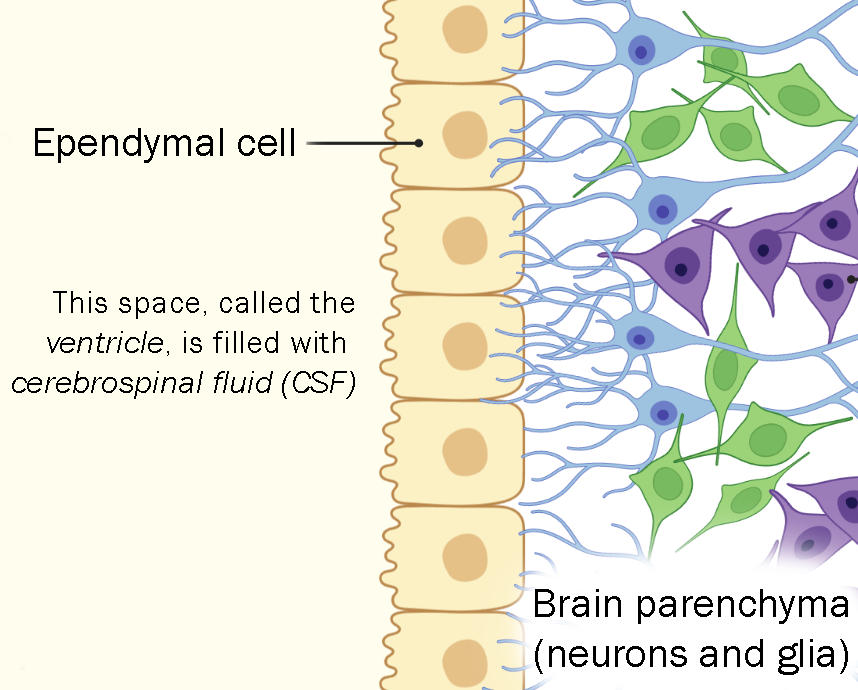 Ependymal cells, along with the border-forming astrocytes, make up a single layer of border cells lining the ventricles. These open spaces in the brain are filled with cerebrospinal fluid (CSF), which bathes, floats, and cushions the brain. CSF circulates continuously, being made by a specific tissue in special locations, traveling through the chambers of the brain and spinal cord, and finally being absorbed into veins at another location. Accordingly, ependymal cells have cilia that continuously “row” CSF through the ventricular system. You will find more about cerebrospinal fluid here.
Ependymal cells, along with the border-forming astrocytes, make up a single layer of border cells lining the ventricles. These open spaces in the brain are filled with cerebrospinal fluid (CSF), which bathes, floats, and cushions the brain. CSF circulates continuously, being made by a specific tissue in special locations, traveling through the chambers of the brain and spinal cord, and finally being absorbed into veins at another location. Accordingly, ependymal cells have cilia that continuously “row” CSF through the ventricular system. You will find more about cerebrospinal fluid here.
Glial Cells of the Peripheral Nervous System

The CNS has immune privilege and ventricles. The PNS lacks both of these features, so the glial cell types carrying these two functions (microglia and ependymal cells, respectively) are absent in the PNS.
Satellite cells in the PNS perform the same basic functions as astrocytes in the CNS: maintenance of a favorable chemical environment and mechanical/structural support. Satellite cells are found mostly in ganglia, collections of nerve cell bodies in the PNS.
Schwann cells are found in the PNS in place of the oligodendrocytes of the CNS. The distinction is not only in its name. There is a functional difference as well: axons ensheathed by oligodendrocytes in the CNS cannot regrow if cut or damaged, while those surrounded by Schwann cells in the PNS can regenerate. For example, if you cut nerves in your finger with a deep knife cut, the finger may be numb for several weeks but eventually, the nerves will regrow.
Similarly, PNS nerves damaged by surgery can regrow, albeit slowly (about 1 mm per day).
1 See, for a thorough analysis of the data on Einstein’s brain: Colombo JA, Reisin HD, Miguel-Hidalgo JJ and Rajkowska G. (2006) Cerebral cortex astroglia and the brain of a genius: A propos A. Einstein’s. Brain Res Rev 52(2): 257-263.
Media Attributions
- Canonical neuron © BioRender adapted by Jim Hutchins is licensed under a CC BY-NC-ND (Attribution NonCommercial NoDerivatives) license
- Healthy neuron © National Institute on Aging, National Institutes of Health is licensed under a CC BY-NC (Attribution NonCommercial) license
- Glial cells © Jonathan Cohen/NIH is licensed under a Public Domain license
- Cajal glia © Santiago Ramón y Cajal is licensed under a Public Domain license
- Astrocytes © Mina Nashed adapted by Jim Hutchins is licensed under a CC BY-NC-ND (Attribution NonCommercial NoDerivatives) license
- Green stained Astrocytes © Jefferey J. Iliff is licensed under a Public Domain license
- Astrocyte © Pasca Lab, Stanford University is licensed under a CC BY-NC (Attribution NonCommercial) license
- Oligodendrocytes © Veronique Miron adapted by Jim Hutchins is licensed under a CC BY-NC-ND (Attribution NonCommercial NoDerivatives) license
- Microglia © Mina Nashed is licensed under a CC BY-NC-ND (Attribution NonCommercial NoDerivatives) license
- Ependymal cells © Carly Rodriguez adapted by Jim Hutchins is licensed under a CC BY-NC-ND (Attribution NonCommercial NoDerivatives) license
- Glia of the PNS © Betts, J. Gordon; Young, Kelly A.; Wise, James A.; Johnson, Eddie; Poe, Brandon; Kruse, Dean H. Korol, Oksana; Johnson, Jody E.; Womble, Mark & DeSaix, Peter is licensed under a CC BY (Attribution) license

